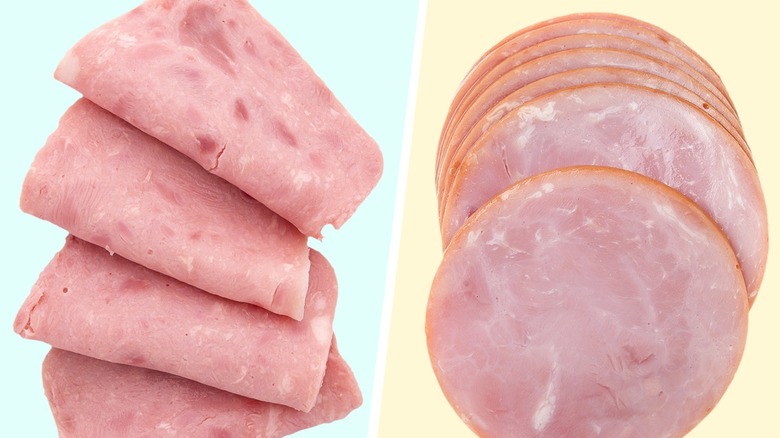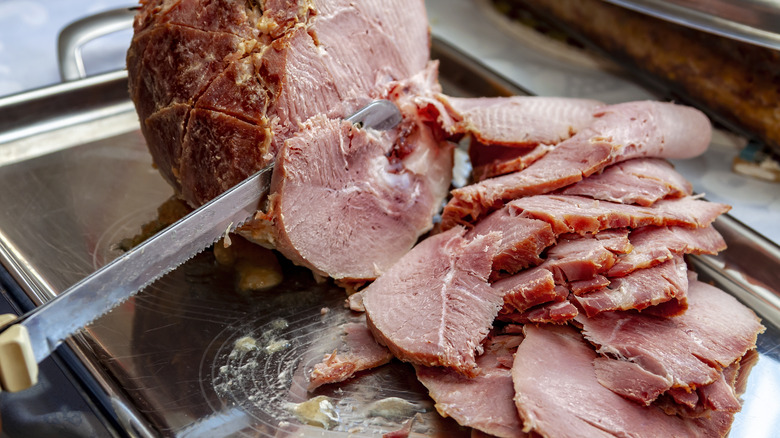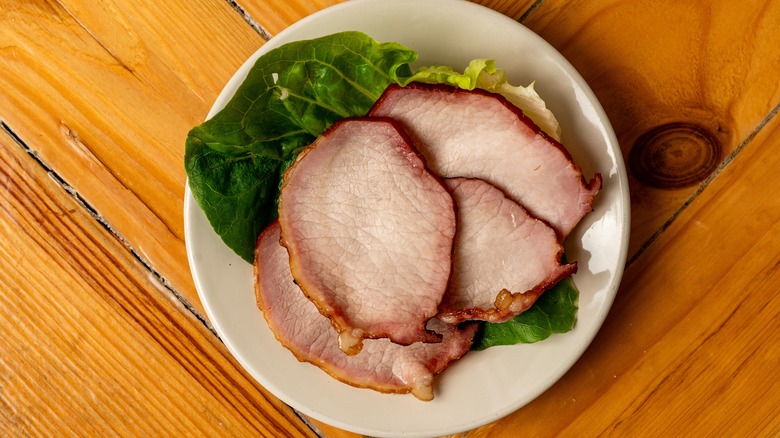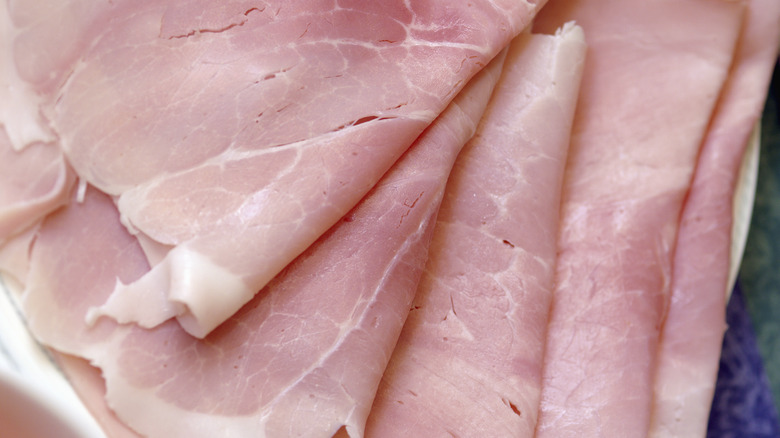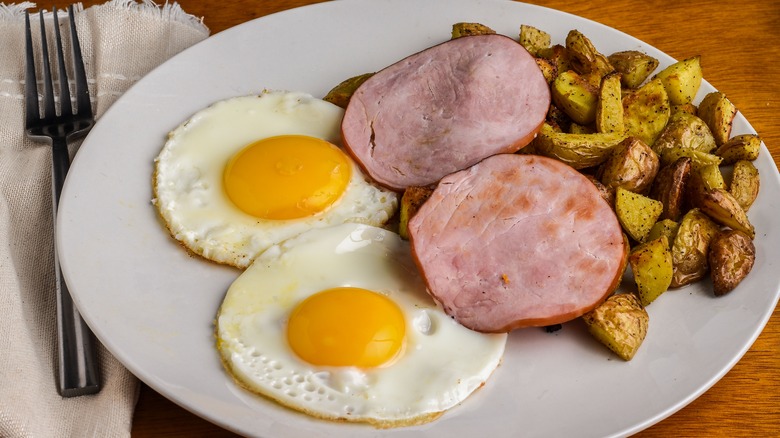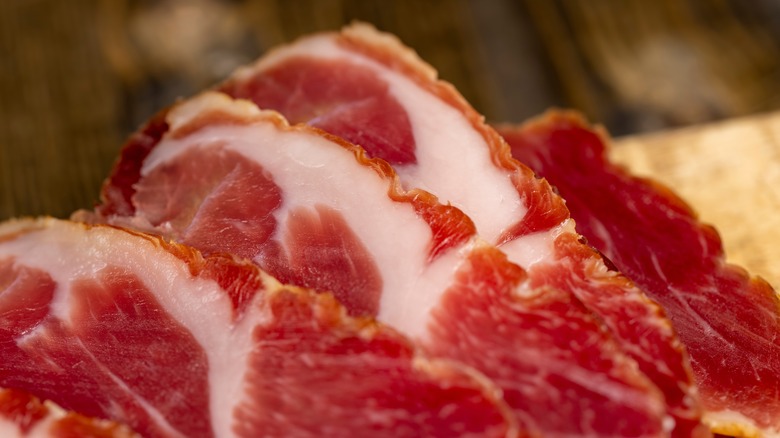What's The Difference Between Ham And Canadian Bacon?
Which side are you on: Canadian bacon or ham? "But Tasting Table!" non-discerning carnivorous foodies cry, "Why pick just one? Can't we enjoy both?" To meat or not to meat, that is the question — and the answer depends on who you're asking.
Taylor Swift named buckwheat crepes with ham, Parmesan, and a fried egg on top as her "go-to breakfast." In one of his many sprawling, heralded innocuous witticisms, The Great Frank Zappa penned the modern parable, "You is what you am. A cow don't make a ham." On the flip side, zoom over to Camp Bacon, and big screen personality Nick Offerman says "It's hard to beat bacon at any time of day." Tom Waits calls the sound of bacon frying in a pan musical, "[I]t sounds like the pops and cracks on an old 33 1/3 recording." But, what about when it comes to Canadian bacon?
At the end of the day, the real question here might not be "which side are you on?" but rather, "What's the actual difference between ham and Canadian bacon, anyway?" Look no further. For starters, these two cuts are from different parts of the hog, and they're prepared using different curing methods, which massively affects the flavor. But, that's just the beginning of this succulent, salty deep-dive.
What is ham?
Ham comes from the large round muscles of the hind leg of the hog, starting at the shank and ending at the rump. It's an ultra-meaty cut — combined, the two hams make up roughly 20% of the total weight of the hog. Before cooking (by whatever preferred cooking process), ham is cured, aged, or smoked, and each of these different methods imparts a unique taste to the meat.
Cured ham (aka "city ham") is the most widely available type of ham. It's injected with a brine of salt, sugar, and a variety of nitrates and sodium additives, then cooked until it reaches 150 degrees Fahrenheit. We'll talk more about aged and smoked hams later. The taste of ham is dense and meaty. It can lean heavier on the sweet, salty, or smoky side depending on how the ham was prepared. But, in general, ham is succulent, tender, and meaty on the palette.
Ham can be sold "fresh" (uncured and uncooked) or prepared (cured, aged, or smoked), but unless you're hitting up a butcher shop, chances are most foodies will probably be encountering prepared hams more commonly than fresh ones. Cured ham can be purchased in most supermarket deli sections, or from bodegas or local standalone delis. In general, hams tend to come pre-cooked, so they'll only need to be reheated to an internal temperature of 140 degrees Fahrenheit to serve.
What is Canadian bacon?
Canadian bacon (aka back bacon or rashers) is made from brined back bacon (not to be confused with streaky bacon or American bacon, which comes from the pork belly). Back bacon comes from the pork loin of a hog, and unlike other types of bacon, back bacon is a relatively lean cut of meat. Whereas ham can be cubed, sliced, or cut into thick steak-like slabs, Canadian bacon comes pre-cut in thick or thin rounds.
Canadian bacon presents a sweet-salty, meaty, pork-forward taste. Unlike shriveling, crispy American bacon, Canadian bacon stays tender, soft, and coin-like when pan-fried due to its lower fat content. In Canada, it's sold in a cylindrical tube shape, pre-cooked and pre-sliced into coins, and perhaps predictably, it's just called "bacon." It can be purchased vacuum-sealed in the breakfast meat section of most grocery stores. If you're looking for fresh, sliced Canadian bacon, swing by your local butcher shop or deli.
They come from different parts of the hog, and they feature different flavors
The foundational difference between ham and Canadian bacon is that they come from different parts of the hog. As mentioned, ham comes from the leg meat or rump, while Canadian bacon comes from the hog's back, aka the pork loin. But, the most obvious difference between ham and Canadian bacon lies in their preparation methods and subsequent flavors.
Canadian bacon is usually sold simply wet-brined in a salt mixture, though online recipes show ways to smoke it or brine it in things like maple syrup. Ham is commonly sold brined, smoked, or aged to cure and it's common to see additional flavorings added to the brine like spicy mustard, brown sugar, or cloves. Black Forest Ham, for instance, is a German variation of city ham that's cured with a highly seasoned brine of juniper berries and garlic. Alternatively, the ham can also be wet-cured by soaking in the brine rather than being injected with it.
Aged ham (aka "country ham") is prepared with a dry rub of salting and seasoning, then hung up in a temperature- and humidity-controlled room to develop a dried, hardened exterior crust, keeping the fresh ham inside safe from spoilage. As a general rule, the drier (i.e. less moisture content) a ham has, the saltier and firmer it will be.
Hams can also be smoked. The type of wood chips used during smoking significantly affects the ham's flavor, with mesquite and hickory being the most common for a mellow flavor and mahogany color. Some hams are smoked after aging, and others are aged after smoking.
Ham is enjoyed at all times of day, whereas Canadian bacon is a breakfast staple
Thanks to their difference in flavors and textures, it only makes sense that ham and Canadian bacon are typically used in different recipes. Most notably, ham is enjoyed as commonly at the breakfast table as at dinner or lunchtime; Canadian bacon is pretty much always a breakfast food.
Cured ham is commonly used in sandwiches and omelets, and whole roasted spiral-cut hams are a fixture on holiday dinner tables on Easter and Christmas. Specialty charcuterie stores and butcher shops are more likely to carry high-end aged hams like Italian prosciutto and Spanish jamón serrano than regular supermarkets. Funky, dried, distinctive-tasting hams like these work beautifully on charcuterie board spreads. Smoked hams might be used in split pea soup, or be sliced into large slabs and perform alone as an entree. Pro tip: If the ham wasn't smoked over wood chips and liquid smoke was injected into the meat, its label will indicate "smoke flavor added."
Canadian bacon is a popular ingredient in many breakfast sandwiches and in traditional eggs benedict under a blanket of lush Hollandaise sauce. It's delicious as a salty-sweet counterbalance to a maple-syrup-loaded pancake stack. As a flavorful protein, Canadian bacon can also be sliced and mixed into stir-fries, quiche, pasta carbonara, roasted vegetables, soups, and stews. Ham and Canadian bacon are often used interchangeably as a Hawaaian-style pizza topping alongside pineapple.
Ham is American (sort of), and Canadian bacon is Canadian (also sort of)
It would feel remiss to talk at length about Canadian bacon without mentioning the geographic indicator in its title, especially compared to the seemingly Everyman's "ham," a monosyllabic label without heritage or creed. It isn't exactly clear what makes Canadian bacon "Canadian." In fact, it's also known as Irish bacon and English bacon. The Canadian label likely emerged during the mid-1800s when a mass pork shortage befell the U.K. To offset the lack, Britain imported a large sum of pork from Canada, brined it, and smoked it, or so the story goes. Nowadays, according to the Canadian Pork Council, a myriad of regional pork-centric dishes belong to different areas in Canada, from Saskatchewan to Manitoba and Ontario, plus some French culinary influence for pork dishes in Quebec.
Ham enjoys a much older history. It originated among foodies in Europe and Asia, particularly China and Rome, where Cato the Elder was writing about the "salting of hams" as early as 160 B.C.E. Eventually, ham made its way to North America with European settlers and took on a new level of popularity in the cold Northeast, as home-curing hams sustained folks through the long fall and winter seasons. Today, ham has a life of its own as a high-grade animal protein in the U.S., with Kentucky and Virginia hams being world-famous and praised for their quality and craft.
